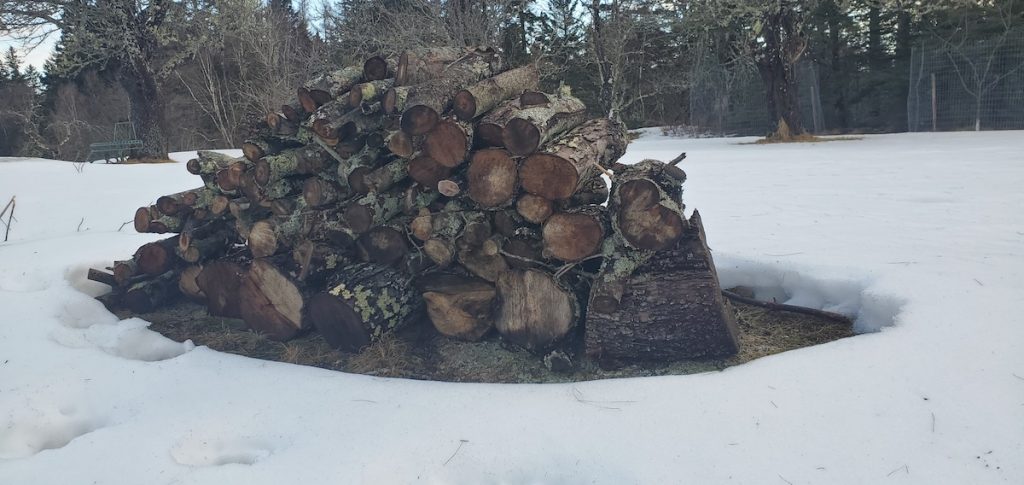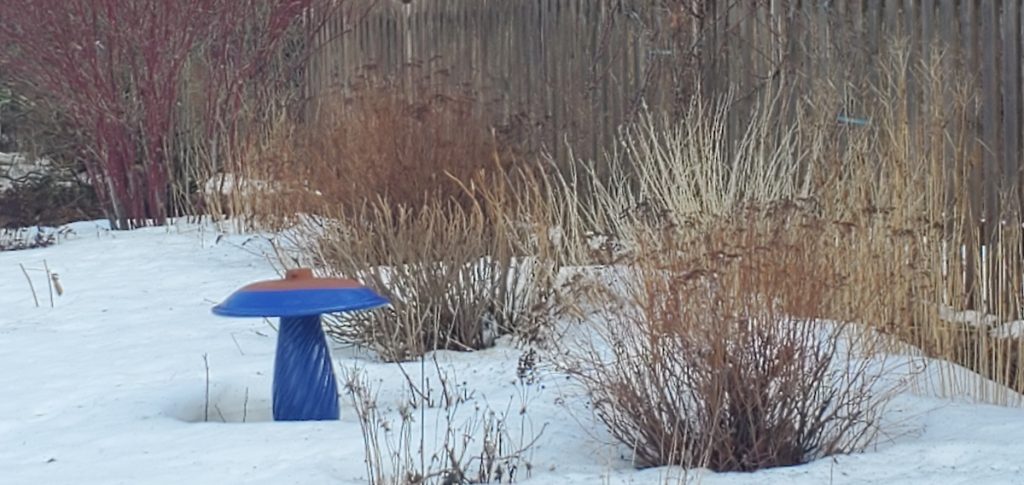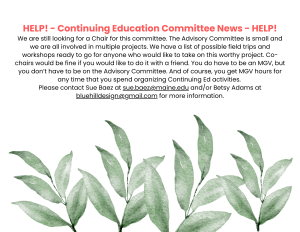Master Gardener Volunteers Newsletter – Hancock County -March 2025
Table of Contents
MGV ADVISORY 2025 / POLLINATOR FRIENDLY GARDENS / MARCH IS THE MONTH TO… / FLASHMOB LOAVES & FISHES / BEE-SAFE PRUNING / CONTINUING ED / LET’S MEET CINDY/ LET’S MEET DAVE / LET’S MEET TERRY / BOOK CLUB / BOOK REVIEW / UPCOMING EVENTS
Upcoming Dates to Remember!
March 28 Spring Pruning Workshop with Frenchman Bay Conservancy
March 30 MOFGA Seed Swap & Scion Exchange
March 31 Intro to Making Compost: Soil Ecosystem Restoration
April 5 Seed Swap at Maine Coast Heritage Trust
April 21 Patriots Day – Office Closed
May 17 Open House at Extension Office – details TBD
Greeting MGVs!
Greetings MGVs! This is the first issue with a new and wonderful Newsletter Committee and there are contributions from all of them! Yay team.
March is almost over; the snow and ice are mostly gone and April is nearly here. April happens to be National Poetry month. Many people are familiar with T.S. Eliot’s famous first phrase of the opening sentence of The Wasteland (1922):
“April is the cruelest month, breeding
Lilacs out of the dead land, mixing
Memory and desire, stirring
Dull roots with spring rain.”
On the other hand, Chaucer’s view of April, from The Prologue to The Canterbury Tales (1476), might be more to your liking:
“When in April the sweet showers fall
That pierce March’s drought to the root and all
And bathed every vein in liquor that has power
To generate therein and sire the flower;”
Read the whole newsletter to see another poet’s lovely take on Spring.
April is also Native Plant Month. More on natives in the next issue. In the meantime, one of our very own has a certified Pollinator-Friendly Garden!
Congratulations, your garden has been certified pollinator-friendly!
By Patty Persson, MGV
The letter received on February 26th started like this: “Your garden in Brooklin, Maine has been certified as Pollinator-Friendly by the University of Maine and UNH Cooperative Extensions.” Wahoo, for an outdoorsy tropical kinda gal who needs the occasional “Atta Girl!”, this letter brought sunshine into an otherwise cold, dark, and blizzardy February day!
To be honest, the application was a joy to complete. It took several long days of re-reading six seasons of gardening notes, cleaning up my “mapping” sketches, and collecting data including the botanical names along with their specific attributes for pollinators. The entire process gave me a chance to put in writing so much of what I have learned through the Master Gardener Volunteer program, and from fellow horticulture enthusiasts, local garden centers, seed catalogs, garden blogs, YouTube videos, neighbors, and more.
What’s good for the pollinators is also good for the soul. Go for it, fellow gardeners. Like me, you may be surprised at all you’ve accomplished just by playing in the dirt.
March is the month to……
By Jonathan Foster, UMaine Cooperative Extension Horticulture Outreach Professional
(Reprinted by permission from Garland, K. Maine Home Garden News – March 2025.
UMaine Extension). Thanks to Pier Carros, MGV
Start seeds indoors
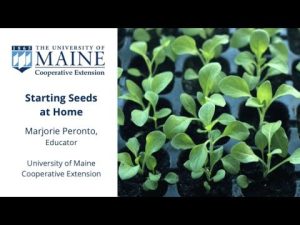 If you’ve never tried starting your own seeds, or you just need a quick refresher, take a peek at our UMaine Cooperative Extension Bulletin #2751, Starting Seeds at Home for full coverage of the topic. While it’s still too early to start tomatoes, zinnia, and many other favorites, here’s what you can sow in March:
If you’ve never tried starting your own seeds, or you just need a quick refresher, take a peek at our UMaine Cooperative Extension Bulletin #2751, Starting Seeds at Home for full coverage of the topic. While it’s still too early to start tomatoes, zinnia, and many other favorites, here’s what you can sow in March:
- Early to mid-March: celery, leeks, parsley, peas, delphinium, butterfly weed, foxglove, and pansy.
- Mid to late March: cabbage, collards, kale, kohlrabi, lettuce, yarrow, verbena, stock, snapdragon, black-eyed Susan, petunia, hollyhock, and blanket flower.
- Late March to early April: artichoke, beets, broccoli, cauliflower, eggplant, Swiss chard, sweet Annie, aster, calendula, bachelor’s buttons, globe amaranth, ornamental kale, larkspur, bee balm, phlox, Iceland poppy, strawflower, sweet pea, and black-eyed Susan vine.
UMaine Extension Starting Seeds YouTube
Get your soil tested
As soon as the snow melts and the soil is workable, you can submit your garden or lawn soil for testing at the UMaine Analytical Soil Lab. Soil test kits and paperwork are available in any Extension office, or you can request a kit online. If you’ve never taken a soil sample before, our colleague Kate Garland has you covered in this fantastic how-to video.
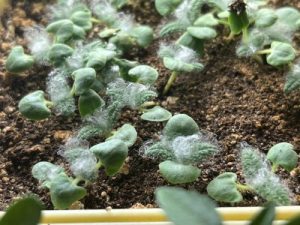
Prune relevant woody plants
Pruning improves the health of your plants, removes unsightly damaged or dead tissue, and manages the habit of the specimen to keep it from growing unruly or inconvenient. UMaine Cooperative Extension Bulletin #2169, Pruning Woody Landscape Plants covers key concepts, includes 5 informative how-to videos, and even has a pruning calendar to guide you through pruning tasks all year. Remember to always use clean, sharp tools (see just below!).
Inventory, clean, and maintain garden tools
March is a great time to make sure your tools are cleaned, oiled, and in working order, and to repair or replace anything that might be broken or missing. Taking care of tools greatly increases their useful lifespan, saving on your gardening budget. The University of Wisconsin Cooperative Extension’s Maintaining Lawn and Garden Tools provides good information on the topic.
Plan the Work, Work the Plan!
by Patti Persson, MGV
2025 Growing Season Fresh from the Loaves & Fishes Neighbor’s Gardens: 
The challenge is real. The pressure is on Hancock and Washington counties to step up production in our community gardens for our local food banks.
We, the MGV’s at Loaves & Fishes Food Pantry have worked out a solid plan to grow high yield, nutritious fruits, vegetables, and herbs for our neighbors. We need your help to work the plan. Please join our team of highly motivated MGV’s on a weekly basis one or more days a week. Times are Monday, Wednesday, and Friday from 9 to noon. If you don’t have three hours, that’s OK; come for as long as you can. Gardening season begins Friday, April 25th. To reserve your times, contact Mary Doherty at mtd432@icloud.com
Bee-Safe Pruning: Spring Pruning Tips for Pollinator Gardens
by Lauren Landers, MGV
In recent years, the “leave the leaves” trend has been catching on as more and more gardeners wait until spring to rake their flower beds. The idea behind this trend stems from the fact that many native pollinators hibernate in old leaf litter during winter, and raking leaves from gardens too early can harm pollinators. However, “leaving the leaves” overlooks the role that hollow-stemmed plants play in the life cycle of native bees, and it fails to consider how spring pruning practices can potentially impact hibernating pollinators too. Although honeybees get a lot of attention in the news, most of the bees that are native to Maine are solitary species that hibernate in burrows in the soil, dead tree cavities, or inside plants with hollow or pithy stems. The problem is, many of these bees can be harmed by raking flower beds too early or pruning perennials too vigorously in spring.
Luckily, by understanding a little bit about native bee lifecycles, we can keep hibernating pollinators safe while still sprucing up our gardens with some springtime pruning! Most stem-nesting bees lay their eggs in hollow plant stems sometime between spring and fall before closing the stems up with a bit of plant debris. Once those eggs hatch, the baby bees spend the winter inside the plant stems and only emerge as fully-formed bees sometime between spring and fall of the following year. Exactly when those stem- nesting bees will emerge varies between species, but following the simple pruning tips below can ensure that even late-emerging bees get a chance to hatch!
- Leave first-year plant stems in place through winter.
- In mid-spring, usually around March or April, prune the perennials that need pruning conservatively. If you’d normally cut plants down to the ground, make your pruning cuts higher — about 12 to 15 inches above the soil line. This opens up the plant stems and allows pollinators to nest and lay their eggs inside!
- Leave this plant stubble in place through the following summer, fall, and winter until the stems naturally degrade into the soil. The stems should be well hidden when your plants leaf out in summer. However, if you suspect that your neighbors may not appreciate this “wilder” garden look, consider adding “Pollinator Garden” signage to your space.
- You can expect baby bees to hatch from the cut stems sometime between spring and fall of the following year.
- Pruning your plants in this manner and leaving longer stems in place each spring should provide ongoing support for new generations of pollinators for many years to come!
If you’d like to do even more to help pollinators in your garden, wait until spring temperatures are consistently in the 50s to rake autumn leaves, and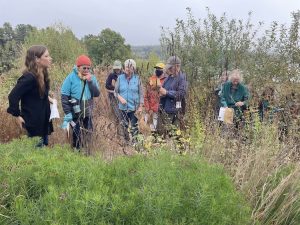 avoid tilling or applying thick layers of heavy wood or bark mulches in Spring. Be sure to add more pollinator-friendly plants like milkweed too, and consider growing more hollow or pithy-stemmed plants specifically for stem-nesting bees. These include many Maine native plants such as Joe Pye weed, cardinal flower, elderberry, ironweed, woodland sunflowers, mountain mint, bee balm, and purple flowering raspberry.
avoid tilling or applying thick layers of heavy wood or bark mulches in Spring. Be sure to add more pollinator-friendly plants like milkweed too, and consider growing more hollow or pithy-stemmed plants specifically for stem-nesting bees. These include many Maine native plants such as Joe Pye weed, cardinal flower, elderberry, ironweed, woodland sunflowers, mountain mint, bee balm, and purple flowering raspberry.
To learn even more about pruning for pollinators, stop by my Spring Pruning Workshop at the Frenchman Bay Conservancy on March 28!
Let’s Meet Cindy Blake – MGV 13′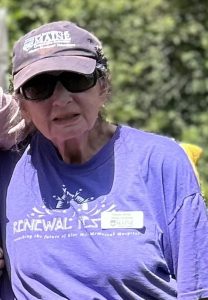
How did I get into gardening? I guess it’s always been a family thing. My grandmothers had fantastic gardens at their houses in Falmouth, my mother always had houseplants, and my father would plant vegetables wherever we lived; and we lived all over the state. (By the way, if you’re driving to Portland and take 295 through Falmouth, you’ll go past the Bucknam Road exit, named for my mother’s mother’s family. Their old house, built around 1730, is still there.)
I always had houseplants, but didn’t get into gardening until a friend and I grew vegetables behind the bar in Chicago where my husband Les worked, near the University of Chicago (how I got there is a long story). Passersbyers really liked my tomatoes that grew along the sidewalk. I brought Les back home to Maine in 1990 and a year later found this old house in Blue Hill. It came with some old flower beds, and it wasn’t long before I started a vegetable garden in the backyard. I downsized to a couple of raised beds closer to the house five years ago.
I retired in December 2012 and immediately signed up for the 2013 Master Gardener Volunteer program. For the two years after that class I was a classroom helper, back in the day when all the classes were at the Extension Office. I’ve worked on several projects over the years, usually weeding: the gardens at the extension office, Native Gardens of Blue Hill, and Hancock County Technical Center Gardens. We once had gardens at Woodlawn in Ellsworth, and I weeded them. One year at Woodlawn, some of us had a compost workshop for kids. I was on the MGV Advisory Committee for four years, starting in 2019. That was in-person until Covid came along, and then we did two years on Zoom. One great thing about in-person meetings at the office was the snacks!
I also gardened for several people on the Blue Hill Peninsula.
I’m looking forward to getting back to cleaning up my gardens in the Spring. We should remember to wait to do that until we’ve had at least one week of 50-degree weather so as not to bother the hibernating pollinators.
Let’s Meet Dave Hollenberg – MGV 15′
Dave grew up in Ohio and graduated from the University of Maine with a degree in chemistry. He worked in the paper industry for 30 years. He moved back to Maine in 2008.
He took the MGV course in 2015 and served as a course assistant afterwards.
He previously served on the Master Gardener Volunteer Advisory Committee and is an active member of the Surry Garden Club as well as the former President. He is also involved in other community groups. He is married and has three grown children.
Meet Terry VanPraet – MGV 20′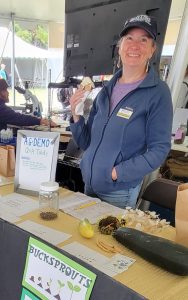
I lived and gardened in New Jersey and Pennsylvania for the first 55 years of my life. After I retired from teaching and decided to move to Maine, I figured it would be a great time to learn more about the specific ecology of Maine and the requirements for successfully growing plants in a more northern climate. Luckily, I learned of the Master Gardener Volunteers program! I graduated with the 2021 cohort.
Most of my volunteer work with MGV the first summer took me to Hancock Community Garden where I tended vegetables for the Harvest for Hunger initiative. I have also worked at Cooperative Extension Office gardens.
While volunteering at Buck Memorial Library, I was asked to create a seed lending library. From my work at the Hancock Community Garden and coursework through the Master Gardener Volunteer program, I knew that food insecurity is a huge issue here. To that end, I created Bucksprouts Seed Lending Library in Bucksport.
I have presented to two garden clubs and had a table at the Common Ground Fair this past September to educate the public of the purpose and benefits of seed libraries and how individuals could create one in their communities.
I am currently working with Stockton Springs Community Library to form a seed lending library there that will support the library’s patrons and the newly forming community garden.
Master Gardener – Book Club News!
Please join us! Hancock/Washington County Master Gardeners’ Book Club.
ALL are welcome. The May meeting is when we choose next year’s books, so there is one meeting left in April if you want to give it a try. We meet once a month, September through May (skipping the month of December) starting at 9am each third Thursday of the month. Those in attendance really enjoy being in touch with other Master Gardeners outside of a garden. It’s energizing, and learning together is especially rewarding. We meet at the Moore Community Center (Art Room) at 5 General Moore Way Ellsworth. The books are typically intriguing and focus on some aspect of the natural world. There are always lively collegial discussions.
April 17, 2025 – Last Book before we break for gardening – Of Time and Turtles by Sy Montgomery, 304 pp
“Compassionate and deeply researched, warm and astonishing, this book is an invitation to slip into turtle time – not the tick-tock hurry of human hustle, but the sacred, eternal time of daylight, darkness, and seasons. It’s a story that shows us a way to mend a world beset with unprecedented perils, shell by shattered shell.”
Please contact this year’s coordinator, Jane Ham, at jdham48@gmail.com if you have any questions regarding the book club, and see for her review of our most recent book below.
Brave The Wild River, The Untold Story of Two Women Who Mapped the Botany of The Grand Canyon by Melissa L. Sevigny
Book Review by Jane Ham, MGV 20′
“Brave The Wild River” is the riveting story of the two women who were the first botanists to survey the plant life of the Grand Canyon. It is also the story of humans trying to conquer, settle, and exploit this magnificent natural wonder.
The story begins in the summer of 1938 with Elzada Clover, Assistant Professor at the University of Michigan, enlisting her protege Lois Jotter, a PhD student, to accompany her on an expedition to “run” the river and collect and document the plant life there. Clover hatched the idea with Norm Nevills who ran a fledgling river charter service out of Medicine Hat, Utah. Nevills had never traveled the entire length of the Grand Canyon and saw this as an opportunity to enhance his reputation and expand his business. Nevills built the boats, recruited two other men, and Clover recruited a male zoologist. The expedition launched on the Green River, on June 20th.
Melissa Sevigny paints a vivid picture of the topography, colors, steep rock formations, violent waters, huge canyon drops, and the plants. Along with entertaining and thrilling details of this expedition, she weaves the story of the National Park Service’s efforts to create a tourist attraction and the disastrous environmental results that followed. Indigenous people who lived for centuries along the river were displaced, as were the men who tried to make their fortunes from the river. She covers efforts to dam the Colorado and the consequences of those actions.
I so enjoyed the story of these women, who defied the critics of women running the river, and quietly, with humor, cooked all the meals, handled all the difficulties of the weather and river, and still managed to collect 400 plants.
The story of the first women to go down the Colorado was a national headline story at the time, then faded and was all but forgotten until this book. Elzada Clover and Lois Jotter went on to have successful academic careers. Clover became a Professor of Botany and Curator of the Botanical Gardens at the University of Michigan. Jotter paused her career for motherhood and widowhood, resuming when her two children were older. She worked as an Assistant Professor of Biology at a college in North Carolina. She helped develop the curriculum for the environmental sciences courses. She was an advocate for women, and a counselor on sex and pregnancy.
In 1944 Clover and Jotter published the complete list of 400 species of plants in the American Midland Naturalist. The list has been a useful and acknowledged reference for botanists and archeologists in the Southwest. Several of the plant species are included in the Smithsonian.
It’s hard to convey how captivating the book is. It’s a true adventure story that was difficult to put down.
Springtime Events for Gardeners
by Nicole Gurreri, MGV 18′
Seed swaps, plant sales, and pruning workshops – oh my!
There are plenty of upcoming gardeners’ events in and around Hancock County. Checkout the
springtime happenings on our radar:
Friday, March 28, 12 – 1 pm
Sunday, March 30, 12 – 4 pm
1st session March 31st, 6 -6:30 pm (on Zoom)
Saturday, April 5, 9 am – 12 pm
Saturday, May 31, 9 a.m – 12 p.m
Saturday, June 14, 2025
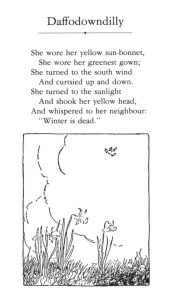
Finally, we leave you with this light-hearted ode to daffodils from AA Milne, first published in his 1924 collection of poems,When We Were Very Young. To the left: Daffodowndilly Graphic – a Milne’s illustration and the text and drawing

